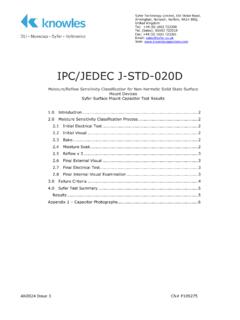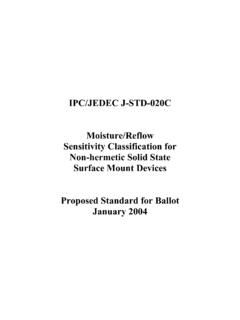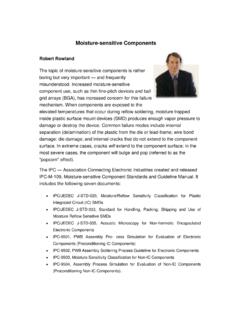Transcription of MOISTURE SENSITIVE COMPONENT STORAGE Hiro …
1 Figure 1 MOISTURE SENSITIVE COMPONENT STORAGEHiro Suganuma/Alvin TamanahaSeika Machinery, , SENSITIVE Devices (MSD) have become widelyused with the increased sophistication of electronicproducts. However, MSDs present a number of challengeswhen used in surface mount assembly as they may sufferinternal damage during the manufacturing process if theyare not handled and stored according to industry surface mount assembly, solder paste is printed on to aPCB, components are mounted and the entire board is sentthrough a reflow oven.
2 In the reflow process the entirePCB and COMPONENT packages are heated along with thesolder and COMPONENT leads. The high reflow temperaturescan cause a package containing MOISTURE to swell and crackaffecting the performance and reliability of the problems are normally the result of poor handlingand STORAGE of MSDs. While most of the damaged components may be detectedprior to shipment of the final product, many make it to themarket place only to fail out in the field. Although acomponent with external cracking may pass pre-shipmentfunctional tests, subsequent high temperature and moistureexposure can induce the transport of ionic contaminantsthrough these openings to the die surface increasing thepotential for failure due to corrosion.
3 Furthermore, internalcracking/delamination can be present even if there is noevidence of external cracks. Ball grid array (BGAs) andchip scale packages (CSPs) are especially SENSITIVE tomoisture and damage to these components can be verydifficult to must pay close attention to their handlingand STORAGE of MSDs to maximize yields and ensure thequality of their finished words: MOISTURE - SENSITIVE devices, MOISTURE barrierbags, dry DO COMPONENTS REQUIRE LOWHUMIDITY STORAGE ?
4 The plastic packaging used to manufacture surface mountdevices (SMD) will absorb MOISTURE from the high temperatures involved in vapor phase/reflowsoldering cause the absorbed MOISTURE to expand rapidly,thus causing internal stress, known as Popcorning. Surface peeling between the die pad and the resin is causedby water vapor pressure during reflow. Surfacedelamination is likely, resulting in shear strain on bondwires and wire necking. Microcracking may extend to theoutside of the package.
5 The SMT reflow process exposes devices to highertemperatures (220 to 235oC) than through-hole devices(135 to 150oC). The solder reflow processes of concern areconvection, convection/IR, infrared (IR), vapor phase(VPR), and hot air rework tools. The use of assemblyprocesses that immerse the COMPONENT body in moltensolder are not recommended for most SMD components. Components are comprised of dies normally made ofsilicon, a die pad made from 42 alloy and various plasticmaterials which make up the body of the COMPONENT .
6 Thematerials that comprise a COMPONENT have different thermalexpansion ratios, adhesive strength and material strengthcharacteristics. Thus, as illustrated Figure 1 above, MOISTURE absorbed by components vaporize during thereflow process. The vapor pressure causes delaminationand cracking in the plastic COMPONENT ProcessStorageMoisture Pressure Die PaddlePackageBuild-upDelamination CrackingBack side CrackSide CrackTop side CrackFigure 2 [1] : COMPONENT crackingExternal cracking may appear on the side, top and bottomside of components.
7 As the package wall is often thinnestbelow the die pad bottom side cracking is the most commonand very difficult to detect visually. Externally crackedcomponents can suffer additional damage due to MOISTURE ,heat and vibration out in the market place. Internally thevapor pressure can create a void allowing the die paddle tomove during temperature cycling. Surface delamination islikely, resulting in shear strain and breakage of bond STANDARD J-STD-033 The guidelines of classification, handling and packing areclearly defined in the IPC/JEDEC Standard J-STD-033 -Standard for Handling, Packing, Shipping and Use ofMoisture/Reflow SENSITIVE Surface Mount Devices.
8 This standard defines the standardized levels of floor lifeexposure for MOISTURE /reflow- SENSITIVE SMDs along withthe handling, packing and shipping requirements necessaryto avoid MOISTURE -reflow-related failures. Companiondocuments, J-STD-020 defines the classification procedure,and JEP113 defines the labeling requirements. Post Exposure to Factory Ambient ConditionsThe standard defines the guidelines of classification,handling, drying and packing of MOISTURE /Reflow Sensitivesurface Mount Devices.
9 MOISTURE SENSITIVE components which have been exposedonly to factory ambient conditions of <60% RH for anylength of time may be adequately dried by high or lowtemperature baking prior to reflow or prior to dry baking resets the floor life clock, however, it canbe a very costly and time consuming process. IPCS tandards requires level 4 components (72 hours floor lifeat 30 OC/60% RH, which make up a majority of Plastic BallGrid Array, PBGA) < mm thick to be baked for 31hours at 125 OC or for 43 days at 40 OC, <5% RH.
10 Most ofMoisture/Reflow SENSITIVE surface Mount Devices Level 2athrough 5a between ~ in thickness are required tobe baked for 48 hours at 125 OC, or for 67~68 days at 40OC, <5% RH. The need for COMPONENT baking can result in decreasedproductivity in high mix production. The baking schedulemust also ensure that components are available prior toassembly. Heating of components in the baking process canincrease the oxidation of leads and result in temperature baking of tape and reel components isextremely costly and time consuming.










